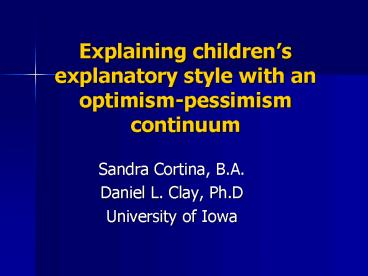Explaining childrens explanatory style with an optimismpessimism continuum PowerPoint PPT Presentation
1 / 10
Title: Explaining childrens explanatory style with an optimismpessimism continuum
1
Explaining childrens explanatory style with an
optimism-pessimism continuum
- Sandra Cortina, B.A.
- Daniel L. Clay, Ph.D
- University of Iowa
2
Introduction
- Explanatory style leads people to respond in
distinct ways at the psychological, behavioral,
and biological levels (Chang, 2000). The
potential instability of explanatory style
provides an opportunity for researchers to
investigate why some children respond more
favorably to health-related situations than
others. However, previous research has limited
results to the pessimistic explanatory style.
3
Purpose
- The purpose of this study was to examine the
reliability, validity, and utility of a
bi-directional measure of explanatory style (the
Optimism-Pessimism Scale-Revised PSM-R).
Children aged 11-15 years were asked to
participate as previous research utilizing the
PSM-R relied upon older respondents (Malinchoc,
et al., 1996).
4
Method
- Participants Sixty-three 6th-9th graders from
predominantly White school districts completed
surveys. Participants were 47 females and 16
males (M 12.5 years, SD1.03 see Table I for
specifics). - Procedure Students were recruited from study
hall and life skills classes in six junior high
and one high school. All questionnaires were
counterbalanced. Movie tickets were awarded to
six random participants when the study was
completed.
5
Method (cont.)
- Measures
- -Revised Childrens Attributional Style
Questionnaire (CASQ-R Kaslow Nolen-Hoeksema,
1991 ). - -Revised Optimism-Pessimism Scale
- (PSM-R Malinchoc, et al., 1996)
- -Childrens Depression Inventory (CDI Kovacs,
1992)
6
Results
- PSM-R Chronbach alphas
- positive items .88 negative items .97
- All correlations were in the expected direction
(see Table II) - Significant gender difference in number of
self-reported depressive symptoms (p.01) - Significant grade differences on CASQ-R and PSM-R
(plt.05) - Sex X Grade interaction not significant
7
Implications Future Directions
- PSM-R evidenced sound internal, construct, and
concurrent validity with children - PSM-R may provide more stable assessment than
CASQ-R - Eighth grade turning point for explanations of
positive events - Confirmation of decline in positive event
explanations needed - Additional reliability and validity information
needed for clinical and research use
8
Table I Descriptives for measure, gender, and
grade
- Variable Mean SD Range N
- PSM-R
- CoPos 763.01 166.84 190.38-1300 63
- CoNeg 579.48 466.44 0.0-1592.03 63
- Overall 54.33 10.07 36-74 63
- CASQ-R
- Positive 7.62 2.03 1.0-11.0 58
- Negative 3.38 1.92 0.0-9.0 58
- Overall 4.52 2.81 -2.0-10 58
- CDI 10.9 8.03 0-36 62
9
Table II Intercorrelations between measures and
age
10
References
- Chang, E. (2000). Optimism pessimism
- Implications for theory, research, and
practice. - Washington, DC American Psychological
Association. - Kaslow, N., Nolen-Hoeksema (1991).
- Childrens Attributional Style
Questionnaire-Revised. - Unpublished manuscript. Emory University.
Atlanta, GA. - Kovacs, M. (1992). Childrens Depression
Inventory - Manual. North Tonawanda, NY Multi-health
Systems, - Inc.
- Malinchoc, M., Colligan, R. C., Offord, K. P.
(1996). - Assessing explanatory style in teenagers
Adolescent - norms for the MMPI optimism-pessimism
scale. Journal - of Clinical Psychology, 52 (3), 285-295.

